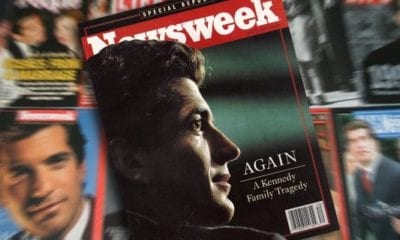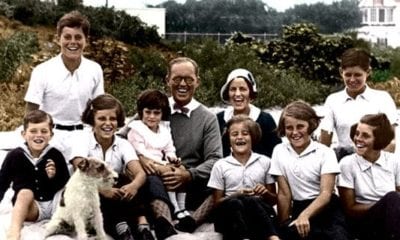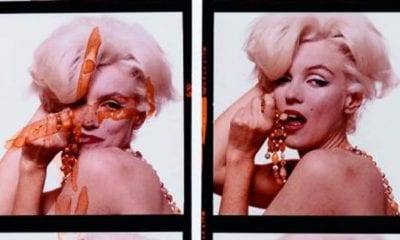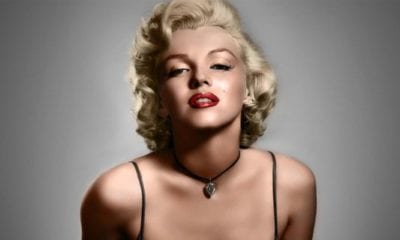Vigilant Reports
The Hidden Life of the Kennedys : The Elite Dynasty That Got Decimated (Pt. II)
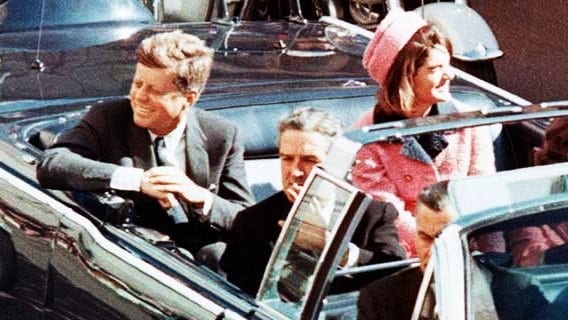
John F. Kennedy was an iconic President who defined an entire era. Although he was placed in office by his powerful father, it seems JFK attempted to cut the strings that turn U.S. presidents into puppets of the country’s shadow government. We will look at the hidden side of the John F. Kennedy presidency.
In the first part of the series, we looked at the rise to power of the Kennedys. You should read that first.
John F. Kennedy’s assassination was nothing less than a turning point in American history. The gunshot that hit Kennedy’s head brutally awakened an innocent American public who then entered a turbulent age of metamorphosis. Roused from the peaceful slumber that was the post-war, baby-boom era of the 50’s, the American public saw a drastic change after the trauma of JFK’s death. This new era was not-so-coincidentally linked with the rise of television and mass media in American homes, which became a powerful engine of change.
JFK was the perfect face of this new era. His natural charisma and charming manners were fully exploited by mass media to turn this politician into a celebrity beloved by the entire country. The feelings of hope and optimism engendered by JFK were not only merely an illusion, however. Records show that he actually tried to bring significant change to his country, by going head-on with the most powerful organizations controlling the country: the CIA, the Federal Reserve, and big oil companies.
Let’s look at JFK’s presidency.
The President for a New Era of Mass Media
JFK was the ultimate prototype of a political figure evolving in the era of mass media. Even before he became President, JFK and his team fully embraced the power of television to gain widespread support. In 1960, Kennedy faced Richard Nixon in the first televised debate in U.S. history and its outcome is now legendary. While Nixon appeared pale, sickly, sweaty and nervous, JFK hired the services of a studio makeup artist to obtain a TV-friendly, healthy glow.
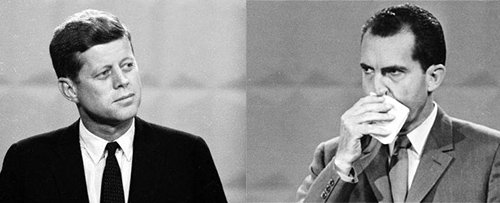
During the presidential debates of 1960, JFK had the calm presence of a seasoned television personality while Nixon kept wiping the sweat off his face, making him appear as the stereotypical “bad guy” we’d see in a movie.
Polls after the debate were quite telling: A slight majority of radio listeners deemed Nixon to be the winner of the debate, while an overwhelming majority of television viewers considered JFK to be the winner. The debate provided a valuable lesson to all future politicians: In the era of television, politics are henceforth about appearances, visceral gut impressions. and sound bites. While watching candidates debate in their living rooms, people could now conclude: “I like this man” or “I don’t trust this man” without even listening to what was said. The outcome of the debate was an important factor leading to JFK’s victory. But that was only the beginning of the “Camelot era”, a King Arthur-inspired term to define the popularity of Kennedy’s era.
After taking office, JFK’s inauguration speech shook the nation. It is now widely considered to be the best speech in American history. It was fully adapted to this new era of mass media and contained the ultimate political soundbite, one that is echoed in mass media to this day.
‘And so, my fellow Americans – ask not what your country can do for you, ask what you can do for your country.’
It was not long before the Kennedys became full-fledged celebrities, evolving in the same media arena as movie stars and pop singers. They appeared in magazine spreads and their fashion sense even contributed to new style trends.
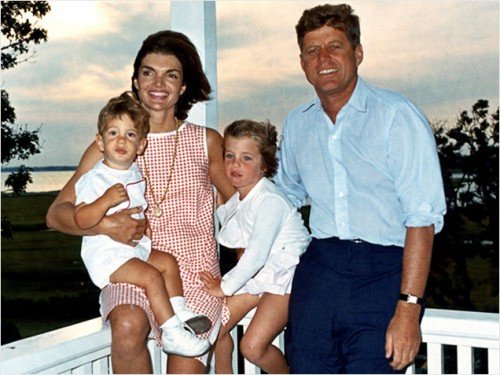
While JFK was the most powerful man in the world, he also used the power of media to convey a casual and family-oriented side, which was relatable to the general public.
JFK was also the first President to have press conferences and public addresses broadcast live on television, marking a new way of conducting politics in the U.S. In short, Kennedy was the first President to be fully present in the arena of mass media, using his charm, charisma, and sex appeal to create a worldwide phenomenon, forever changing the world of politics.
While mass media great amplified every aspect of JFK’s life, it was his untimely death that caused one of the biggest mass media moments in history. The hours, days and months following his assassination were a turning point in journalism, as we witnessed a new era of live television news feeds.

Walter Cronkite announcing JFK’s death is a defining moment in U.S. history. Visibly shaken, Cronkite removed his glasses and addressed a nation that was in complete shock. This moment also marks the transition period between old-time written news and live television coverage.
Because JFK’s aura was so amplified by mass media, his death caused a shock-wave of trauma and dismay across America and the world. It was one of the first mega-rituals conducted by a shadow elite … but far from the last. After JFK, several personalities were literally built by mass media to then die and cause shock and trauma. The era of mass media also corresponds to a new era of control by the occult elite.
Links With the Darker Side of Hollywood
While JFK enjoyed the status of a Hollywood celebrity, he also partook in the darker aspects of it. During the 1960s, Hollywood decidedly steered towards sexual exploitation, mind control, and dark occultism, and JFK was close friends with its main figures, namely: Frank Sinatra, Peter Lawford, and Sammy Davis, Jr., a.k.a “the rat pack”. According to Fritz Springmeier, these men were MK slave handlers, linked with Anton LaVey’s Church of Satan.
Many of the movies and shows use Monarch slaves as actors & performers. They also use lots of slave handlers such as Frank Sinatra, Peter Lawford, & Bob Hope. And occasionally the use programmers such as Anton LaVey, Jerry Lee Lewis. (…)
Frank Sinatra has been a slave handler. He has handled Bob Hope’s slaves, when Bob Hope has lent them to the Rat Pack (which consisted of Dean Martin, Frank, Sammy Davis, Jr. Peter Lawford & Joey Bishop). Frank Sinatra spends time with the Rockefellers and the Rothschilds.
– Fritz Springmeier, The Illuminati Formula to Create a Mind Control Slave
Recently released FBI files describe “sex parties” attended by the Kennedy brothers, Sammy Davis, Jr., Frank Sinatra (an MK slave handler) and Marilyn Monroe (a Beta Programming slave).
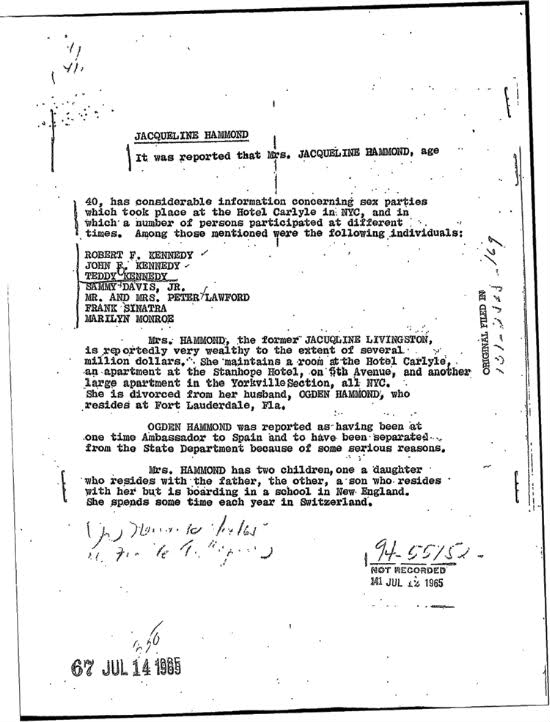
An FBI file describing a party that included the Kennedys, members of the Rat Pack, and Marilyn Monroe.

Sammy Davis Jr. with Anton LaVey, the head of the Church of Satan – a powerful organization that put a “Hollywood” facade on hardcore Satanism.
JFK’s string of affairs with various partners during his Presidency is no secret today. The two most famous women associated with JFK are Marilyn Monroe and Jayne Mansfield, two blonde movie stars with strikingly similar personas. There is, however, another point they both have in common: They were both “partners” of Anton LaVey. In fact, Mansfield was a “High Priestess” of his Church of Satan.
In San Francisco for the 1966 Film Festival, Mansfield visited the Church of Satan with Sam Brody (her lawyer and boyfriend) to meet Anton LaVey, the church’s founder. LaVey awarded Mansfield a medallion and the title “High Priestess of San Francisco’s Church of Satan”. The Church of Satan proclaimed Jayne a pledged member, and she displayed a framed membership certification in her pink bedroom. The media enthusiastically covered the meeting and the events surrounding it, identifying her as a Satanist and romantically involved with LaVey. That meeting remained a much-publicized and oft-quoted event of her life, as well as the history of the Church of Satan
– Strait, Raymond (1974). Tragic Secret Life of Jayne Mansfield.
The link between Marilyn Monroe, Jayne Mansfield, Anton LaVey and JFK is not simply the result of a coincidence. Behind his theatrical facade, Anton LaVey was an MK ULTRA handler who programmed Monroe and Mansfield to be Beta Kittens.
“Anton LaVey has been the mind-control handler/programmer of a number of Hollywood actors & actresses, including Jayne Mansfield and Marilyn Monroe, who both serviced him as sexual slaves”.
– Anton Szandor LaVey, Whale.to“Marilyn Monroe was an orphan, and during her infancy the Illuminati/CIA programmed her to be a Monarch slave. Before becoming an actress, while she was still a stripper, she spent time with the founder of the Church of Satan Anton LaVey. Victims of LaVey have pointed him out as a mind-control programmer.”
– Ibid.
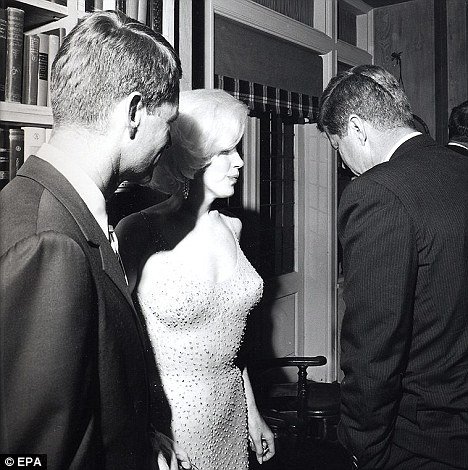
Marilyn Monroe speaks with John F. Kennedy after famously singing him “Happy Birthday, Mr. President”. Wearing her iconic diamond-studded dress (diamonds are associated with Presidential Models in MK symbolism), the performance was actually a Beta Kitten sensually singing to the man she is servicing.
Like most MK slaves, Monroe and Mansfield died young (at age 36 and 34 respectively) and in odd circumstances (“overdose” and car accident).
A Bold President
Despite all of the partying and distractions, JFK was a busy and dedicated President. While he dealt with gigantic issues such as the rise of civil rights and the Cold War, he also dealt with lesser-known issues. Indeed, JFK quickly understood who was in charge in Washington and that it was not him, the supposed democratically-elected President. It was the shadowy elite who controlled the country from behind the scenes, through various powerful groups, who worked completely independently from the government. In what appears to be an attempt to bring power and influence back to democratically elected representatives, JFK clashed with the CIA, the Federal Reserve, big oil and even the military-industrial complex. Almost all of the policies adopted that went against these groups were quickly reversed after his death.
Against the Fed?
The Federal Reserve System was created in 1913 to become the central banking system of the United States. However, despite its “governmental name”, the Federal Reserve System is not federal. It is not even governmental. Although it was created by an act of Congress, the Federal Reserve is completely independent of the government. It is essentially a private organization owned by twelve credit monopolies, which are owned by the most powerful banking families in the world.
Black Law’s Dictionary defines the Fed as a:
“Network of twelve central banks to which most national banks belong and to which state chartered banks may belong. Membership rules require investment of stock and minimum reserves.”
The Federal Reserve is the entity that lends money to banks, who then lend money to citizens, with interest. More importantly, the Fed creates U.S. money, which it loans to the U.S. government, also while charging interest. The government must then collect income taxes to pay this interest. The sixteenth amendment, which gave Congress the power to collect income taxes, was passed the same year the Fed was created.
In 1934, Congressman Louis T. McFadden of Pennsylvania gave an astounding speech exposing who was behind the Fed. According to him, it was the same people who are behind important world events. Without naming them, McFadden described the elite bloodlines of the world.
“Mr. Chairman, we have in this Country one of the most corrupt institutions the world has ever known. I refer to the Federal Reserve Board and the Federal Reserve Banks, hereinafter called the Fed. The Fed has cheated the Government of these United States and the people of the United States out of enough money to pay the Nation’s debt. The depredations and iniquities of the Fed has cost enough money to pay the National debt several times over.
“This evil institution has impoverished and ruined the people of these United States, has bankrupted itself, and has practically bankrupted our Government. It has done this through the defects of the law under which it operates, through the maladministration of that law by the Fed and through the corrupt practices of the moneyed vultures who control it.
“Some people who think that the Federal Reserve Banks are United States Government institutions. They are private monopolies which prey upon the people of these United States for the benefit of themselves and their foreign customers; foreign and domestic speculators and swindlers; and rich and predatory money lender. In that dark crew of financial pirates there are those who would cut a man’s throat to get a dollar out of his pocket; there are those who send money into states to buy votes to control our legislatures; there are those who maintain International propaganda for the purpose of deceiving us into granting of new concessions which will permit them to cover up their past misdeeds and set again in motion their gigantic train of crime.
“These twelve private credit monopolies were deceitfully and disloyally foisted upon this Country by the bankers who came here from Europe and repaid us our hospitality by undermining our American institutions. Those bankers took money out of this Country to finance Japan in a war against Russia. They created a reign of terror in Russia with our money in order to help that war along. They instigated the separate peace between Germany and Russia, and thus drove a wedge between the allies in World War. They financed Trotsky’s passage from New York to Russia so that he might assist in the destruction of the Russian Empire. They fomented and instigated the Russian Revolution, and placed a large fund of American dollars at Trotsky’s disposal in one of their branch banks in Sweden so that through him Russian homes might be thoroughly broken up and Russian children flung far and wide from their natural protectors. They have since begun breaking up of American homes and the dispersal of American children. “Mr. Chairman, there should be no partisanship in matters concerning banking and currency affairs in this Country, and I do not speak with any.
“The Federal Reserve Bank destroyed our old and characteristic way of doing business. It discriminated against our 1-name commercial paper, the finest in the world, and it set up the antiquated 2-name paper, which is the present curse of this Country and which wrecked every country which has ever given it scope; it fastened down upon the Country the very tyranny from which the framers of the Constitution sough to save us.
In this speech of rare veracity, Congressman McFadden refers to “bankers who came here from Europe” and who use their immense wealth to influence world events who even pushed for a Russian revolution. His description of the “bankers” is perfectly applicable to an elite family like the Rothschilds, a dynasty of bankers from Europe who has been financing the war efforts of several countries for centuries.
That being said, was Kennedy actively working against the Fed or not? To this day, this question is still hotly debated. Some argue that JFK issued an executive order going against the Fed, others claim that he actually made the Fed stronger. There appears to be a great deal of contradictory information and disinformation floating around on the subject, a classic sign of being a “sensitive” issue.
In his 1990 book Crossfire, Jim Marrs states that five months before his assassination, JFK signed Executive Order 11110, allowing the government to issue interest-free money by bypassing the entire Federal Reserve system.
Another overlooked aspect of Kennedy’s attempt to reform American society involves money. Kennedy apparently reasoned that by returning to the constitution, which states that only Congress shall coin and regulate money, the soaring national debt could be reduced by not paying interest to the bankers of the Federal Reserve System, who print paper money then loan it to the government at interest. He moved in this area on June 4, 1963, by signing Executive Order 11,110 which called for the issuance of $4,292,893,815 in United States Notes through the U.S. Treasury rather than the traditional Federal Reserve System. That same day, Kennedy signed a bill changing the backing of one and two dollar bills from silver to gold, adding strength to the weakened U.S. currency.
Kennedy’s comptroller of the currency, James J. Saxon, had been at odds with the powerful Federal Reserve Board for some time, encouraging broader investment and lending powers for banks that were not part of the Federal Reserve system. Saxon also had decided that non-Reserve banks could underwrite state and local general obligation bonds, again weakening the dominant Federal Reserve banks.
A number of “Kennedy bills” were indeed issued – the author has a five dollar bill in his possession with the heading “United States Note” – but were quickly withdrawn after Kennedy’s death. According to information from the Library of the Comptroller of the Currency, Executive Order 11,110 remains in effect today, although successive administrations beginning with that of President Lyndon Johnson apparently have simply ignored it and instead returned to the practice of paying interest on Federal Reserve notes. Today we continue to use Federal Reserve Notes, and the deficit is at an all-time high.”
– Jim Marrs, Crossfire
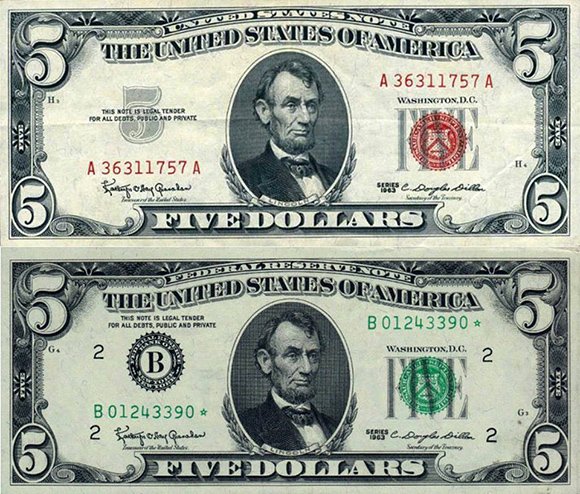
A comparison of a “United States Note” (top) as issued by the U.S. government and a regular “Federal Reserve Note” (bottom) as issued by the Fed. Although the bills are esthetically similar, the United States Note is debt-free, interest-free and bypasses the entire parasitical Federal Reserve System.
According to Marrs, the Executive Order was an effort by Kennedy to transfer power from the Federal Reserve to the United States Department of the Treasury by replacing Federal Reserve Notes with Silver Certificates. Here is the Executive Order :
SECTION 1. Executive Order No. 10289 of September 9, 1951, as amended, is hereby further amended (a) By adding at the end of paragraph 1 thereof the following subparagraph (j):
‘(j) The authority vested in the President by paragraph (b) of section 43 of the Act of May 12, 1933, as amended (31 U.S.C. 821(b)), to issue silver certificates against any silver bullion, silver, or standard silver dollars in the Treasury not then held for redemption of an outstanding silver certificates, to prescribe the denominations of such silver certificates, and to coin standard silver dollars and subsidiary silver currency for their redemption,’ and (b) By revoking subparagraphs (b) and (c) of paragraph 2 thereof.
SECTION 2. The amendments made by this Order shall not affect any act done, or any right accruing or accrued or any suit or proceeding had or commenced in any civil or criminal cause prior to the date of this Order but all such liabilities shall continue and may be enforced as if said amendments had not been made.
John F. Kennedy,
THE WHITE HOUSE,
June 4, 1963.
However, Marrs’ theory was challenged by observers who state that Executive Order 11110 does not mention the creation of four billion dollars worth of “United States Notes” and is merely an amendment of a 1951 Executive Order pertaining delegating powers to the Secretary of the Treasury in issues pertaining to silver certificates.
Against the CIA and war?
Kennedy’s Presidency took place in a time period where the United States and the USSR were playing a game of chess on a worldwide scale. Through a variety of covert operations, the CIA fermented revolutions, funded armed groups, and assassinated leaders to gain control of several parts of the globe. During Kennedy’s presidency, the Cold War caused conflicts in areas including Vietnam, Laos, and Cuba.
In 1961, Kennedy authorized the Bay of Pigs Invasion, the long-planned invasion of Cuba using a CIA-sponsored paramilitary group named “Brigade 2506”. The ultimate goal was the overthrow (or assassination) of Fidel Castro. The operation ended up failing, causing JFK to publicly take the blame for it. Kennedy was then quoted as telling an official within his administration: “I want to splinter the CIA into a thousand pieces and scatter it to the winds.” A few months later, CIA director Allen Dulles, Deputy Director for Plans Richard M. Bissell, Jr., and Deputy Director Charles Cabell were all forced to resign. After Kennedy’s death, Allen Dulles was part of the Warren Commission that investigated JFK’s assassination – a nomination that still raises eyebrows to this day.
In 1963 Kennedy learned about the assassination of the president of South Vietnam, Ngo Dinh Diem, which was first disguised as a suicide by the CIA. The bloody coup reportedly shook JFK to the core.
“According to General Maxwell Taylor, “Kennedy leaped to his feet and rushed from the room with a look of shock and dismay on his face which I had never seen before.” Kennedy had planned that Ngô Đình Diệm would be safely exiled and Arthur M. Schlesinger, Jr. recalled that the U.S. president was “somber and shaken”. Kennedy later penned a memo, lamenting that the assassination was “particularly abhorrent” and blaming himself for approving Cable 243, which had authorised Lodge to explore coup options in the wake of Nhu’s attacks on the Buddhist pagodas. Forrestal said that “It shook him personally … bothered him as a moral and religious matter. It shook his confidence, I think, in the kind of advice he was getting about South Vietnam.”
– Halberstam, David Singal, Daniel J, “The Making of a Quagmire: America and Vietnam during the Kennedy Era”
In the last days of his administration, JFK took several steps in reducing the number US soldiers in Vietnam and planned to ultimately achieve a complete withdrawal. Recordings of Defense Secretary McNamara and Vice-President Lyndon Johnson both have accounts of JFK wanting to pull out of Vietnam after his reelection in 1964 (they were both against it).
Kennedy reinforced his stance for peace on June 10, 1963, when he delivered an important speech at American University:
To discuss a topic on which too often ignorance abounds and the truth is too rarely perceived—yet it is the most important topic on earth: world peace … I speak of peace because of the new face of war…in an age when a singular nuclear weapon contains ten times the explosive force delivered by all the allied forces in the Second World War … an age when the deadly poisons produced by a nuclear exchange would be carried by wind and air and soil and seed to the far corners of the globe and to generations yet unborn … I speak of peace, therefore, as the necessary rational end of rational men … world peace, like community peace, does not require that each man love his neighbor—it requires only that they live together in mutual tolerance … our problems are man-made—therefore they can be solved by man. And man can be as big as he wants.
About a month before his assassination, JFK signed the National Security Action Memorandum (NSAM) 263 ordering the withdrawal of 1,000 military personnel from Vietnam by the end of the year. However, on November 26, 1963, only four days after Kennedy’s death, Lyndon Johnson passed NSAM 273 which reversed the withdrawal and reinforced U.S. commitment in Vietnam.
Against Big Oil?
Ever since the days of Rockefeller’s Standard Oil, big oil companies have enjoyed great privileges and influence in the United States. For example, since 1926, oil companies benefit from large tax concessions, including the oil depletion allowance, which allows them to keep 27.5 percent of their revenue tax-free.
In 1963, President Kennedy proposed removing the oil depletion allowance, the main tax incentive for oil companies. Estimates showed that it would have cost Texas oilmen $300 million in profits each year. He also passed the Kennedy Act, a piece of legislation that especially pinched oil companies, which would have caused them to give up 15 percent of their profits on foreign investments.
After Kennedy’s death, his successor Lyndon Johnson, who was extremely close to Texas oil companies, completely abandoned these plans.
In Conclusion
Although it is easy to either deify or vilify JFK, the truth is that he was merely a man who was a product of his environment – the occult elite. As a member of this rarefied group, he mixed with the dark side of Hollywood and got involved with the horrendous world of MK slaves and handlers.
However, on a professional level, Kennedy went against the best interests of the elite on several occasions by attempting to go against the CIA, the Federal Reserve, the military-industrial complex, and big oil companies. Indeed, Kennedy took bold steps towards limiting the powers of organizations who act in total secrecy and who give absolutely no accounts of their actions to the public. He went against the shadow government which works in the dark and, soon after, he was assassinated in broad daylight. Fifty years later, the official theory is that a lone gunman killed Kennedy. Is that plausible? In the decades that followed, the dreaded Kennedy curse continued, decimating the most prominent members of the family. Was the Kennedy dynasty shunned by the occult elite?
The last part of the series looks at JFK’s assassination, its occult meaning, and the fate of the rest of the Kennedy dynasty.
- Mockery Ensues
- Official seal of the University of Chile
- New footage shows debauched birthday party Diddy threw for Meek Mill
- The Economist / 2025 / The World Ahead
- Justin Trudeau claims fighting climate change is more important than feeding your kids
- Suspect at center of ISIS inspired Election Day terror plot previously worked for the CIA
- Nina Saemundsson's "Prometheus Bringing Fire" (Los Angeles McArthur Park, circa 1937)
Get an e-mail notification as soon as a new article is published on The Vigilant Citizen.
-
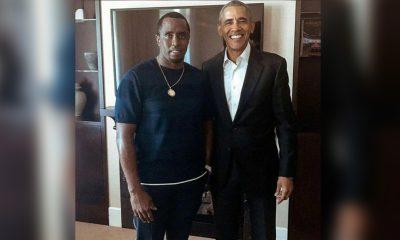
 Latest News2 months ago
Latest News2 months agoThe Controlled Demolition of Diddy
-
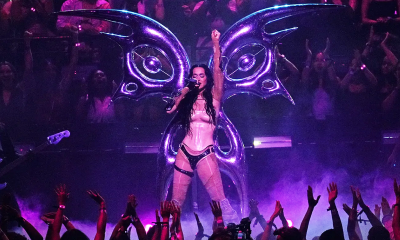
 Music Business2 months ago
Music Business2 months agoThe Hidden Meaning of Katy Perry’s Highly Symbolic Performance at the 2024 VMAs
-
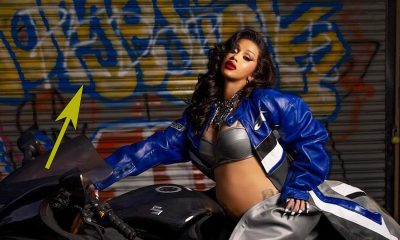
 Pics of the Month2 months ago
Pics of the Month2 months agoSymbolic Pics of the Month 09/24
-
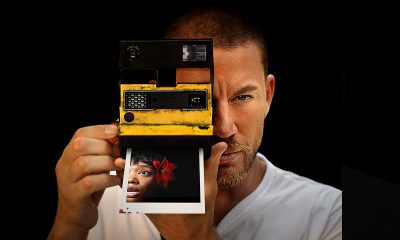
 Movies and TV1 month ago
Movies and TV1 month agoAn In-Depth Look at the Hidden Meaning and Symbolism in “Blink Twice”
-

 Pics of the Month4 weeks ago
Pics of the Month4 weeks agoSymbolic Pics of the Month 10/24
-

 Music Business3 months ago
Music Business3 months agoSomething’s Terribly Wrong With Sabrina Carpenter and her Video “Taste”
-

 Movies and TV2 months ago
Movies and TV2 months agoAn In-Depth Look at the Dark Messages and Symbolism in “Longlegs”
-

 Latest News2 weeks ago
Latest News2 weeks agoKamala’s Campaign Was Objectively the Worst in Recent History



